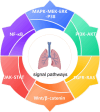Progress of CCL20-CCR6 in the airways: a promising new therapeutic target
- PMID: 39731176
- PMCID: PMC11681768
- DOI: 10.1186/s12950-024-00427-5
Progress of CCL20-CCR6 in the airways: a promising new therapeutic target
Erratum in
-
Correction: Progress of CCL20-CCR6 in the airways: a promising new therapeutic target.J Inflamm (Lond). 2025 Jan 13;22(1):2. doi: 10.1186/s12950-025-00428-y. J Inflamm (Lond). 2025. PMID: 39806407 Free PMC article. No abstract available.
Abstract
The chemokine CCL20, a small cytokine that belongs to the C-C chemokine family, interacts with its homologous receptor CCR6, which is expressed on wide range of cell types. According to current research, the CCL20-CCR6 has been established as acritical player in a diverse range of inflammatory, oncogenic, and autoimmune diseases. Within the respiratory system, CCL20-CCR6 demonstrates heightened expression in conditions such as allergic asthma, chronic airway inflammation, non-small cell lung cancer (NSCLC), chronic obstructive pulmonary disease (COPD), and other respiratory diseases, which is conducive to the inflammatory mediators recruitment and tumor microenvironment remodeling. Numerous studies have demonstrated that therapeutic interventions targeting CCL20 and CCR6, including antibodies and antagonists, have the potential to mitigate disease progression. Despite the promising research prospects surrounding the CCL20-CCR6 chemokine axis, the precise mechanisms underlying its action in respiratory diseases remain largely elusive. In this review, we delve into the potential roles of the CCL20-CCR6 axis within the respiratory system by synthesizing and analyzing current research findings. Our objective is to provide a comprehensive understanding of the CCL20-CCR6 axis and its implications for respiratory health and disease. And we aspire to propel research endeavors in this domain and furnish valuable insights for the development of future therapeutic strategies.
Keywords: CCL20; CCR6; Immunoreaction; Inflammation; Respiratory system.
© 2024. The Author(s).
Conflict of interest statement
Declarations. Competing interests: The authors declare no competing interests.
Figures


Similar articles
-
CCL20-CCR6 signaling in tumor microenvironment: Functional roles, mechanisms, and immunotherapy targeting.Biochim Biophys Acta Rev Cancer. 2025 Jul;1880(3):189341. doi: 10.1016/j.bbcan.2025.189341. Epub 2025 May 8. Biochim Biophys Acta Rev Cancer. 2025. PMID: 40348067 Review.
-
The CCL20-CCR6 Axis in Cancer Progression.Int J Mol Sci. 2020 Jul 22;21(15):5186. doi: 10.3390/ijms21155186. Int J Mol Sci. 2020. PMID: 32707869 Free PMC article. Review.
-
Involvement of CCR6/CCL20/IL-17 axis in NSCLC disease progression.PLoS One. 2011;6(9):e24856. doi: 10.1371/journal.pone.0024856. Epub 2011 Sep 15. PLoS One. 2011. PMID: 21949768 Free PMC article.
-
CCR6-CCL20 axis as a therapeutic target for autoimmune diseases.Autoimmun Rev. 2021 Jul;20(7):102846. doi: 10.1016/j.autrev.2021.102846. Epub 2021 May 7. Autoimmun Rev. 2021. PMID: 33971346 Review.
-
Accumulation of dendritic cells and increased CCL20 levels in the airways of patients with chronic obstructive pulmonary disease.Am J Respir Crit Care Med. 2007 May 15;175(10):998-1005. doi: 10.1164/rccm.200608-1113OC. Epub 2007 Mar 1. Am J Respir Crit Care Med. 2007. PMID: 17332482
Cited by
-
Dysbiosis and extraintestinal cancers.J Exp Clin Cancer Res. 2025 Feb 7;44(1):44. doi: 10.1186/s13046-025-03313-x. J Exp Clin Cancer Res. 2025. PMID: 39915884 Free PMC article. Review.
References
-
- Lin S, et al. PM(2.5) and its components and respiratory disease healthcare encounters - unanticipated increased exposure-response relationships in recent years after environmental policies. Environ Pollut. 2024;360:124585. - PubMed
-
- Ono SJ, et al. Chemokines: roles in leukocyte development, trafficking, and effector function. J Allergy Clin Immunol. 2003;111(6):1185–99 quiz 1200. - PubMed
-
- Reibman J, et al. Airway epithelial cells release MIP-3alpha/CCL20 in response to cytokines and ambient particulate matter. Am J Respir Cell Mol Biol. 2003;28(6):648–54. - PubMed
Publication types
Grants and funding
LinkOut - more resources
Full Text Sources

